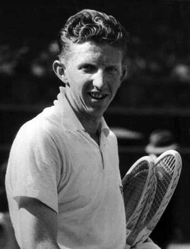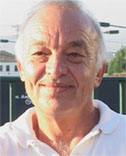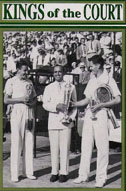J. Donald Budge
By Ed Atkinson
 |
An absolute natural, Don Budge created the concept of the Grand Slam. |
J. Donald Budge: the hero of every tennis player who ever saw him play, and a man whose backhand is considered the greatest shot in the history of the game.
Budge was an absolute natural, who never played tennis seriously until he was 14. As he himself told the story, his older brother, Lloyd, challenged him: "Don, you'd have a good chance to win the California State Boy's 15 and Under if you practice, but you're too darned lazy to practice, so forget it."
Two weeks before the tournament, Budge started going up to Bushrod Park, a few blocks away from his house, and playing anyone who showed up with a racquet. That preparation bore fruit. In the first round, Budge beat the number one seed and went on to win the tournament.
No one played off the ground better than Don Budge The most devastating aspect of his game was his return. No one could follow his serve to the net against him. Jack Kramer is on record as saying Budge was the best tennis player he ever saw play the game.
Budge had an aura of greatness. He had a way of making other players feel like they should be his ball boy. He loved the glamour and he was glamorous himself. He drank champagne, he listened Tommy Dorsey, he played the drums.
Budge made a premeditated and calculated effort to make tennis history and win the first Grand Slam of tennis: the championships of England, France,.Australia and the United States.
This was of course before air travel, when a sea journey to Australia lasted 22 days. Budge put an exclamation point on his amazing feat by only losing five sets in 28 matches.
By late 1935, Don Budge had begun to hit his full stride as a totally dominating tennis player. It was not uncommon him to win seven or eight games in a row, regardless of how well his opponent was playing.
He was the absolute master of the all court game who never seemed to have a bad day. No one will ever know how good Budge really was because World War II came along to disturb his reign.
 |
Budge was an absolute master of the all court game. |
But the mental anguish that Budge could cause his opponents with his sustained bombardments is illustrated by the 1935 Pacific Southwest Final. Budge was playing Czechoslovakia's Roderick Menzel in a 3 out of 5 set match.
Menzel started fast, won the first set and led five games to one in the second. At this point in the match, Budge raised his game. Menzel began to experience that most dreaded of tennis calamities, being totally overwhelmed while playing one's best.
Budge's relentless onslaught earned him the second and third sets. Down 2 sets to 1, Menzel retrieved all his racquets and started to walk off the court.
He was intercepted by the tournament director, who informed him that the match was the best of 5 sets. In response Menzel asked, "Do you think Donald Budge is a better tennis player than I am?"
"Yes, I do," answered the tournament director. "I agree with you completely," said Menzel as he walked through the clubhouse exit without looking back.
Because of the pressure he applied, Budge could play with an effortless elegance that belied his blazing foot speed.
There is the legendary tale of Bobby Riggs and Don Budge strolling along Fifth Avenue in New York during the national championships.
Riggs was needling Budge, claiming it was a good thing that he hit the ball so well because he certainly couldn't run very fast. Don turned to him and said, "What makes you think you're so fast?"
Soon they were engaged in a 75 yard race along 5 th Avenue. Both players put up $10. Budge beat him by about six yards, leaving Riggs in disbelief.
Budge has explained that his legendary backhand was a completely natural stroke. Starting tennis late, he had played a lot of baseball. Although he was a right handed thrower, Budge was a left handed batter. He would take the racquet back with two hands, then I'd let go and hit with one.
Budge came over the ball, hitting it on the rise, versus another legendary backhand in tennis history, that of Ken Rosewall, who hit under the ball with slice. Budge would stand in close and make contact before the ball got too high, hitting slightly over the ball if anyone endeavored to come into the net.
 |
Budge believed his greatest win was over Baron Gotfried VonCramm in the 1937 Davis Cup Final. |
According to Budge, his greatest high was beating Baron Gottfried Von Cramm in the Davis Cup final in 1937. Budge had beaten him in three straight sets in the finals a week before at Wimbledon.
Just as the two players were leaving the locker room and the phone rang. It was Adolph Hitler calling the Baron to wish him good luck. But Budge never believed that Von Cramm was a Nazi.
Although Budge played just as well as he did at Wimbledon, Von Cramm played much better and won the first two sets. Budge managed to win the next two sets but was down 4-2 in the 5 th.
At this point Budge changed his tactics and decided that if Von Cramm missed his first serve, he was going to attack the second serve and go in behind his return.
Von Cramm missed four first serves in a row by inches, and Budge attacked, hitting very close to baseline, coming in and making four winning volleys. Budge broke him at love, then broke him again with the same strategy.
The match ended with Budge holding serve. On match point he made the greatest shot of his life.
Von Cramm hit a cross court shot to his forehand on a sharp angle. As Budge was running for the ball he realized he was going to fall. He took a swipe at the ball and landed on his stomach. He looked up and saw the ball pass Von Cramm,going around the net post and landing six inches inside the baseline.
In his heyday, Don Budge was probably the best striker of the ball who ever lived. In 1962, when Rod Laver equaled his feat of winning the Grand Slam, the first person to walk on the court and congratulate him was Don Budge.





